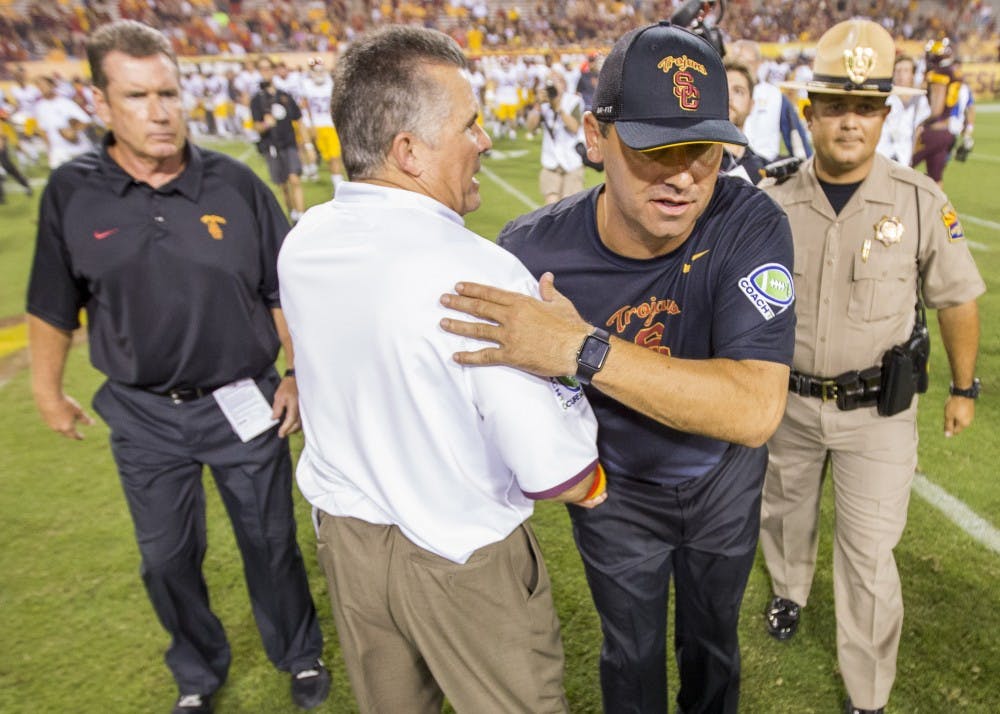If you’re interested in an FBS head-coaching position, it might be time to send off your resume and cover letter.
I’m being facetious, but it’s not even Halloween and there are seven FBS vacancies. Spooky.
Plenty more jobs will open up after the season, but these days it seems like athletic directors don’t have the patience to stick out the season with their head football coach, and the coaches quit when things don’t go well.
I mean, why delay what you know is already coming?
“When something is inevitable, I believe you do it right then,” ex-South Carolina coach Steve Spurrier said at his closing news conference. “You don’t wait a week, you don’t wait two weeks.”
At Maryland, reports surfaced that the Terrapins planned to fire Randy Edsall after the Ohio State game (Edsall had signed an extension before the season). When that came to public light, there was no chance for the coach to survive.
Miami also caved to pressure by firing Al Golden the day after the Hurricanes suffered their worst defeat ever.
Cincinnati leads Miami 27-20 at halftime under the eye of the Fire Al Golden banner plane http://t.co/QjkJhcnAr6 pic.twitter.com/SjfsqsdAgc
— CBS Sports CFB (@CBSSportsCFB) October 2, 2015
North Texas similarly fired its coach after a bad 66-7 loss to FCS Portland State (who has also beat 5-2 Washington State).
In the case of USC, second-year coach Steve Sarkisian was fired after showing up to work while drunk and while at Illinois, fifth-year coach Tim Beckman was canned after an internal investigation revealed Beckman pressured players to compete while injured.
Spurrier and Central Florida’s George O’Leary were already on the fast-track to retirement but both quit mid-season because their teams weren’t very good.
Spurrier resigned after a 2-4 start, but apparently still has time to go on ESPN College GameDay. If South Carolina was an SEC East contender, he likely would have stuck out the season, planning to exit on his team’s shoulders after the SEC championship game.
O’Leary planned on retiring after the season, but his team was 0-8, fast tracking his exit plan.
Whatever happened to gutting it out? Finishing what you started? Coaches would rather quit if their team stinks than close out the year. It’s the same from the other side of the athletic director and coaching spectrum. On two occasions this year, schools canned their coach after a blowout loss.
What advantage do you really gain by firing someone midseason? It could be useful if you wanted to hire a coach without a school. Arizona was able to get a jump-start its program when it hired Rich Rodriguez before Thanksgiving in 2011 (he was working as a CBS analyst). But if you want an NFL coach, you’ll have to wait until after their season.
In American sports, there isn’t a job with more pressure than a major college football coach.
The NFL might have more fans, but college coaches answer to more people. They have to please boosters, who influence decisions by donating/reneging money dependent on a coach. They need to entice recruits, even though the odds are that the coach won’t still be at the school by the time the recruit exhausts eligibility (three-year median tenure entering 2015).
The pressure from outside and within has led to the current predicament: A lot of teams are without a coach.
Related Links:
Scouting the Oregon Ducks: Q & A with The Daily Emerald
Oregon looms in ASU football's path toward strong finish
Reach the columnist at jmjanss1@asu.edu or follow @jjanssen11 on Twitter.
Like State Press Sports on Facebook and follow @statepresssport on Twitter.




